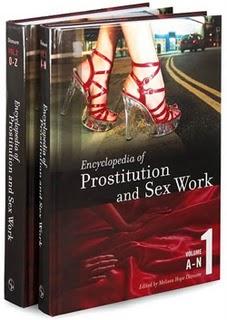Encyclopedia of Prostitution and Sex Work

Five thousand words, much less the 500 allowed here, are insufficient to review critically and appreciate properly a reference work this exciting, valuable, unique and scrupulously edited. Into two sturdy, attractive-looking and easy-to-use volumes, Melissa Hope Ditmore has assembled 341 entries from 179 experts from fields and perspectives as disparate as criminal justice and sex worker activism, pop culture studies and Asian history, musicology and English literature, cinematic studies and international health, and performance art and social services. Intriguing information is presented regarding persons such as Ah Toy, Candy Barr, J. Edgar Hoover, Catherine Mackinnon, Annie Sprinkle, and Emile Zola. Well-informed essays about the structure and function of prostitution and sex work have been contributed for cities such as Bangkok, Havana, and New York, and in geographic regions such as Australia and New Zealand, the 19th-century American West and Southeast Asia. Specific sex industries in times and places as different as Imperial Russia, Medieval Europe, Vietnam-era Thailand, and pre-Revolution Shanghai are examined in often surprisingly close historical detail. Many contributors have analyzed the “labor forms” that sex work and prostitution can take, as the anthropologist Luise White has dubbed them, such as street-walking, massage, brothels, outcall and escort services, and the venues at which they can occur - including cribs, bars and cafes, display windows, highway-stopovers, dormitories, and barracks.
“Sex work” is defined as encompassing “prostitution,” but also including "phone sex, pornography, stripping, and erotic dancing,” The Preface, Introduction and many other sections and introductions thereto make immediately evident the participation of bell-boys and blues singers, cab-drivers and clients, priests and police chiefs, alongside the expected madams, pimps and providers of sexual services. Many of the relevant mental, sexual, and public health precursors and consequences are also done justice in entries that cover sexually transmitted diseases, Tenofovir, Post-Traumatic Stress Disorder, microbicides, and abortion. Representations in the form of stigma, poetry, cinematic (s), exploitation, music, zoning, guidebooks and many, many feminisms make these two volumes especially useful for academics and theorists. Although selling for $225, institutions, departments, libraries, organizations and collectives will find immediate usefulness in the broad array of subjects, personalities, statutes and issues covered here quite succinctly, including primary documents, poems and song lyrics, for example, to the “House of the Rising Sun.”
In only 819 pages, and with equal parts authority and freshness, a dazzling array of intellectual, political, medical, historical and sexual concerns have been covered. Colonialism, AIDS, religion, the Internet, globalization and migration and mobility are each explored in always sober, often lively prose. Remarkably few typos mar the text, and its presentation has been augmented by helpful appendices and indexes, and by many black-and-white photos, movie stills and drawings.
The editor, contributors and advisory board members are to be congratulated also for having responsibly walked that razor’s edge of attempting to write and edit fairly about something as protean as sexual networking, something that so vividly reveals tensions between structure and agency, Church and State, labor and capital, exploitation and choice, horror and love.
Reviewer’s disclaimer: The fact that the reviewer contributed five entries to this collection has not influenced the content of his review, which was written solely to obtain a free, review copy he could not otherwise afford (or live without).
Thank you, anonymous and b for your comments, and yes, I believe that you ought to contact libraries, institutions and whatnot to order copies of the book, which is unique and ground-cutting or path-clearing or whatever in many, many ways. Not many books will have the currency this one will have in two or three decades. Books are expensive to produce these days. I hope that that they come out with a paperback version or something like that. Cheers. Lawrence Hammar
I like the reviewer's disclaimer. It may be expensive, but I still think it's cool to draw attention to this collection. Maybe we can get our libraries to carry it?
It really is a great collection. My only complaint is the price may put off too many people who need to read this.Should prostitution be legal?